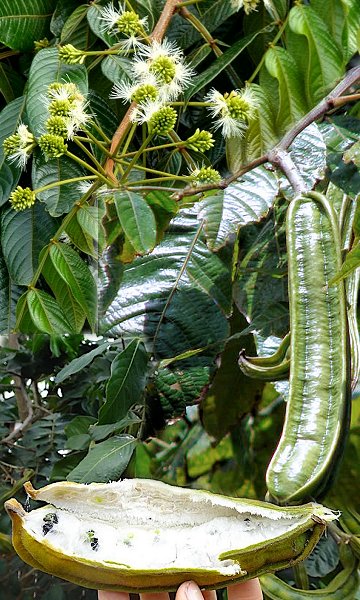
|
|
Ice Cream Bean
(Inga edulis). Flowers and fruits.
|
Ice Cream Bean - Inga edulis
Inga edulis, known as ice cream-bean, joaquiniquil, cuaniquil, guama or guaba, is a fruit
tree native to South America. It is in the mimosoid tribe of the legume family Fabaceae. It is widely grown, especially by Indigenous Amazonians, for shade, food, timber, medicine, and production of the alcoholic beverage cachiri. It is popular in Peru, Ecuador, Pernambuco-Brazil, Venezuela and Colombia. The taxonomic name Inga is derived from its name with the Tupí people of South America, while the species name edulis is Latin for "edible". The common name "ice-cream bean" alludes to the sweet flavor and smooth texture of the pulp.
Mature trees of Inga edulis reach 30 m (98 ft) high and 60 cm (2.0 ft) diameter at breast height, usually branching from below 3 m (9.8 ft). The branches form a broad, flat, moderately dense canopy. Inga edulis can be evergreen in tropical regions or deciduous when planted in colder regions. The tree has a pale grey coloured trunk. The stems and young twigs can be sparsely to densely haired.
The leaves are alternate, evenly pinnate, 10–30 cm long with 4–6 pairs of opposite, dark-green, membranous, slightly pubescent, oval leaflets. The terminal leaflets can grow up to 18 cm long by 11 cm wide in comparison to the basal ones. Extrafloral nectaries are placed on petioles and stipules can be either inconspicuous, absent, or caduceus.
Flowers are fragrant, sessile, pentamerous and are arranged in dense axillary spikes. The flower has a calyx tube with five puberulent, striate lobes, corolla with five silky, villous petals. These are around 14–20 mm long and contain numerous white stamens.
The fruits are longitudinally ribbed, cylindrical indehiscent leguminous pods which can be straight, curved or often spirally twisted up. They are pendant and up to 1 m long and yellowish brown to greenly coloured. The amount of ovoid seeds can vary from 10 to 20, which are purplish-black to olive colored. These are embedded in the sweet, cottony, white arillus which gives it the name Icecream bean, since they taste sweet.
Inga edulis has been cultivated as a fruit tree for millennia and is widely sold on the local South American marketplace, mainly for the sweet, succulent pulp surrounding the seeds. The white pulp (aril) is consumed raw as a sweet snack, though it is less nutritious than the seeds. Toxic compounds such as trypsin and chymotrypsin inhibitors contained in the seeds of Inga edulis are destroyed through cooking.
The taste is described as resembling that of vanilla ice cream. Some varieties,
much esteemed in Ecuador, even possess a slight cinnamon flavor. The seeds are only edible when cooked and have a taste similar to that of chickpeas.
In Colombia the arils are also used to prepare an alcoholic beverage called cachiri for a festival of the same name. The native women chew the arils and spit the mixture into a vat, where it is left to ferment. The fruit ripens quickly and can only be kept for three to four days, limiting potential export opportunities. However, refrigeration can extend shelf life to about three weeks.
Inga edulis is widely used in native South American folk medicine. Decoctions of the leaves, bark or root commonly are utilized as treatments for diarrhea, arthritis and rheumatism. Crushed, boiled leaves are ingested to relieve coughing or applied to lip sores, possibly caused by herpes. Several studies have investigated Inga edulis as a source of polyphenols for use as antioxidants and have shown promising results.
Due to its rapid growth and ability to improve soil properties, Inga edulis has found widespread use in tropical agroforestry. Most notably, Inga alley cropping is used as an alternative to slash and burn cultivation. It is also a popular shade tree for coffee, cocoa and tea plantations. One important reason for this is that in comparison to other shade tree species Inga edulis retains its leaves in the dry season. Cuttings and leaves also used as mulch and animal
fodder. The wood is sometimes used as timber and for fuel, its popularity as a source of firewood stemming from its high calorific value and weak smoke production.
Source:
https://en.wikipedia.org/wiki/Inga_edulis
https://pfaf.org/user/Plant.aspx?LatinName=Inga+edulis
